2,3-Dihydro-1,4-benzodioxine-2-carbonyl chloride
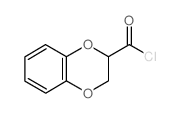
2,3-Dihydro-1,4-benzodioxine-2-carbonyl chloride structure
|
Common Name | 2,3-Dihydro-1,4-benzodioxine-2-carbonyl chloride | ||
|---|---|---|---|---|
| CAS Number | 3663-81-8 | Molecular Weight | 198.60300 | |
| Density | 1.374g/cm3 | Boiling Point | 279.9ºC at 760mmHg | |
| Molecular Formula | C9H7ClO3 | Melting Point | 56-59ºC | |
| MSDS | USA | Flash Point | 123.2ºC | |
| Name | 2,3-Dihydro-1,4-benzodioxine-2-carbonyl chloride |
|---|---|
| Synonym | More Synonyms |
| Density | 1.374g/cm3 |
|---|---|
| Boiling Point | 279.9ºC at 760mmHg |
| Melting Point | 56-59ºC |
| Molecular Formula | C9H7ClO3 |
| Molecular Weight | 198.60300 |
| Flash Point | 123.2ºC |
| Exact Mass | 198.00800 |
| PSA | 35.53000 |
| LogP | 1.59180 |
| Index of Refraction | 1.556 |
Synonym:1,4-Benzodioxan-2-carbonyl chlorid Section 2 - COMPOSITION, INFORMATION ON INGREDIENTS
Risk Phrases: 34 Section 3 - HAZARDS IDENTIFICATION EMERGENCY OVERVIEW
Causes burns.Moisture sensitive. Potential Health Effects Eye: Causes eye burns. Skin: Causes skin burns. Ingestion: Causes gastrointestinal tract burns. Inhalation: Causes chemical burns to the respiratory tract. Chronic: Not available. Section 4 - FIRST AID MEASURES Eyes: Immediately flush eyes with plenty of water for at least 15 minutes, occasionally lifting the upper and lower eyelids. Get medical aid immediately. Skin: Get medical aid immediately. Immediately flush skin with plenty of water for at least 15 minutes while removing contaminated clothing and shoes. Ingestion: Do not induce vomiting. Get medical aid immediately. Inhalation: Get medical aid immediately. Remove from exposure and move to fresh air immediately. If not breathing, give artificial respiration. If breathing is difficult, give oxygen. Notes to Physician: Treat symptomatically and supportively. Section 5 - FIRE FIGHTING MEASURES General Information: As in any fire, wear a self-contained breathing apparatus in pressure-demand, MSHA/NIOSH (approved or equivalent), and full protective gear. Extinguishing Media: Use foam, dry chemical, or carbon dioxide. Section 6 - ACCIDENTAL RELEASE MEASURES General Information: Use proper personal protective equipment as indicated in Section 8. Spills/Leaks: Vacuum or sweep up material and place into a suitable disposal container. Section 7 - HANDLING and STORAGE Handling: Do not breathe dust, vapor, mist, or gas. Do not get in eyes, on skin, or on clothing. Use only in a chemical fume hood. Storage: Store in a cool, dry place. Store in a tightly closed container. Corrosives area. Store under nitrogen. Section 8 - EXPOSURE CONTROLS, PERSONAL PROTECTION Engineering Controls: Facilities storing or utilizing this material should be equipped with an eyewash facility and a safety shower. Use adequate ventilation to keep airborne concentrations low. Exposure Limits CAS# 3663-81-8: Personal Protective Equipment Eyes: Not available. Skin: Wear appropriate protective gloves to prevent skin exposure. Clothing: Wear appropriate protective clothing to prevent skin exposure. Respirators: Follow the OSHA respirator regulations found in 29 CFR 1910.134 or European Standard EN 149. Use a NIOSH/MSHA or European Standard EN 149 approved respirator if exposure limits are exceeded or if irritation or other symptoms are experienced. Section 9 - PHYSICAL AND CHEMICAL PROPERTIES Physical State: Solid Color: cream Odor: Not available. pH: Not available. Vapor Pressure: Not available. Viscosity: Not available. Boiling Point: Not available. Freezing/Melting Point: Not available. Autoignition Temperature: Not available. Flash Point: Not available. Explosion Limits, lower: Not available. Explosion Limits, upper: Not available. Decomposition Temperature: Solubility in water: Specific Gravity/Density: Molecular Formula: C9H7ClO3 Molecular Weight: 199 Section 10 - STABILITY AND REACTIVITY Chemical Stability: Not available. Conditions to Avoid: Incompatible materials, exposure to moist air or water. Incompatibilities with Other Materials: Strong oxidizing agents, bases, amines. Hazardous Decomposition Products: Hydrogen chloride, chlorine, carbon monoxide, carbon dioxide. Hazardous Polymerization: Has not been reported Section 11 - TOXICOLOGICAL INFORMATION RTECS#: CAS# 3663-81-8 unlisted. LD50/LC50: Not available. Carcinogenicity: 2,3-Dihydro-1,4-benzodioxine-2-carbonyl chloride - Not listed by ACGIH, IARC, or NTP. Section 12 - ECOLOGICAL INFORMATION Section 13 - DISPOSAL CONSIDERATIONS Dispose of in a manner consistent with federal, state, and local regulations. Section 14 - TRANSPORT INFORMATION IATA Shipping Name: CORROSIVE SOLID, ACIDIC, ORGANIC, N.O.S.* Hazard Class: 8 UN Number: 3261 Packing Group: III IMO Shipping Name: CORROSIVE SOLID, ACIDIC, ORGANIC, N.O.S. Hazard Class: 8 UN Number: 3261 Packing Group: III RID/ADR Shipping Name: CORROSIVE SOLID, ACIDIC, ORGANIC, N.O.S. Hazard Class: 8 UN Number: 3261 Packing group: III Section 15 - REGULATORY INFORMATION European/International Regulations European Labeling in Accordance with EC Directives Hazard Symbols: C Risk Phrases: R 34 Causes burns. Safety Phrases: S 26 In case of contact with eyes, rinse immediately with plenty of water and seek medical advice. S 36/37/39 Wear suitable protective clothing, gloves and eye/face protection. S 45 In case of accident or if you feel unwell, seek medical advice immediately (show the label where possible). WGK (Water Danger/Protection) CAS# 3663-81-8: No information available. Canada None of the chemicals in this product are listed on the DSL/NDSL list. CAS# 3663-81-8 is not listed on Canada's Ingredient Disclosure List. US FEDERAL TSCA CAS# 3663-81-8 is not listed on the TSCA inventory. It is for research and development use only. SECTION 16 - ADDITIONAL INFORMATION N/A |
| Hazard Codes | Xi: Irritant; |
|---|---|
| Risk Phrases | R34 |
| Safety Phrases | 26-36/37/39 |
| RIDADR | UN 3261 |
| HS Code | 2932999099 |
|
~99% 
2,3-Dihydro-1,4... CAS#:3663-81-8 |
| Literature: FENG, Yangbo; LOGRASSO, Philip; BANNISTER, Thomas; SCHROETER, Thomas; FANG, Xingang; YIN, Yan; CHEN, Yen Ting; SESSIONS, Hampton; CHOWDHURY, Sarwat; LUO, Jun-Li; VOJKOVSKY, Tomas Patent: WO2010/56758 A1, 2010 ; Location in patent: Page/Page column 50-51 ; WO 2010/056758 A1 |
|
~% 
2,3-Dihydro-1,4... CAS#:3663-81-8 |
| Literature: Bioorganic and Medicinal Chemistry Letters, , vol. 24, # 7 p. 1766 - 1770 |
|
~% 
2,3-Dihydro-1,4... CAS#:3663-81-8 |
| Literature: Farmaco, , vol. 44, # 11 p. 1109 - 1117 |
| HS Code | 2932999099 |
|---|---|
| Summary | 2932999099. other heterocyclic compounds with oxygen hetero-atom(s) only. VAT:17.0%. Tax rebate rate:13.0%. . MFN tariff:6.5%. General tariff:20.0% |
| 2-benzodioxanylcarbonyl chloride |
| 1,4-benzodioxane-2-carbonyl chloride |
| 1,4-BENZODIOXAN-2-CARBONYL CHLORIDE |
| benzodioxane-2-carboxylic acid |
| chlorure del' acide benzodioxanne carboxylique-2 |
| BUTTPARK 364-48 |
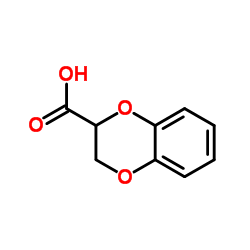
![2,3-Dihydro-benzo[1,4]dioxine-2-carboxylic acid methyl ester structure](https://image.chemsrc.com/caspic/074/3663-79-4.png)
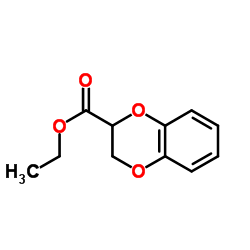
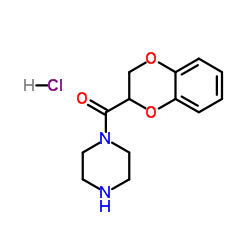 CAS#:70918-74-0
CAS#:70918-74-0![4-[(2,3-DIHYDRO-1,4-BENZODIOXIN-2-YLCARBONYL)AMINO]BENZENECARBOXYLIC ACID structure](https://image.chemsrc.com/caspic/223/309923-57-7.png) CAS#:309923-57-7
CAS#:309923-57-7![N-[1-(2,3-dihydro-1,4-benzodioxin-3-ylmethyl)piperidin-4-ylidene]hydroxylamine structure](https://image.chemsrc.com/caspic/298/89483-71-6.png) CAS#:89483-71-6
CAS#:89483-71-6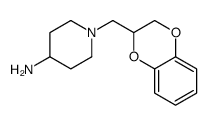 CAS#:89483-72-7
CAS#:89483-72-7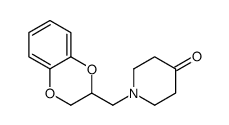 CAS#:53491-25-1
CAS#:53491-25-1